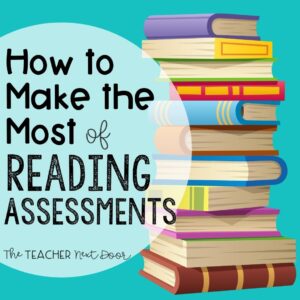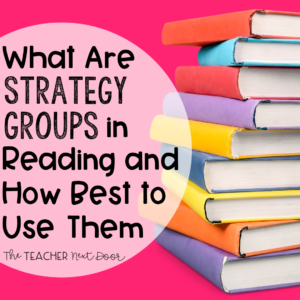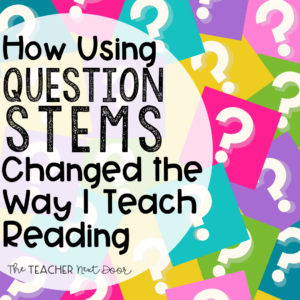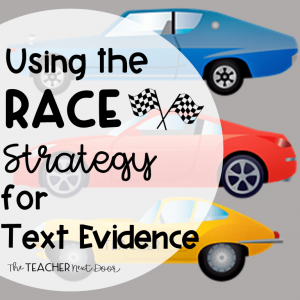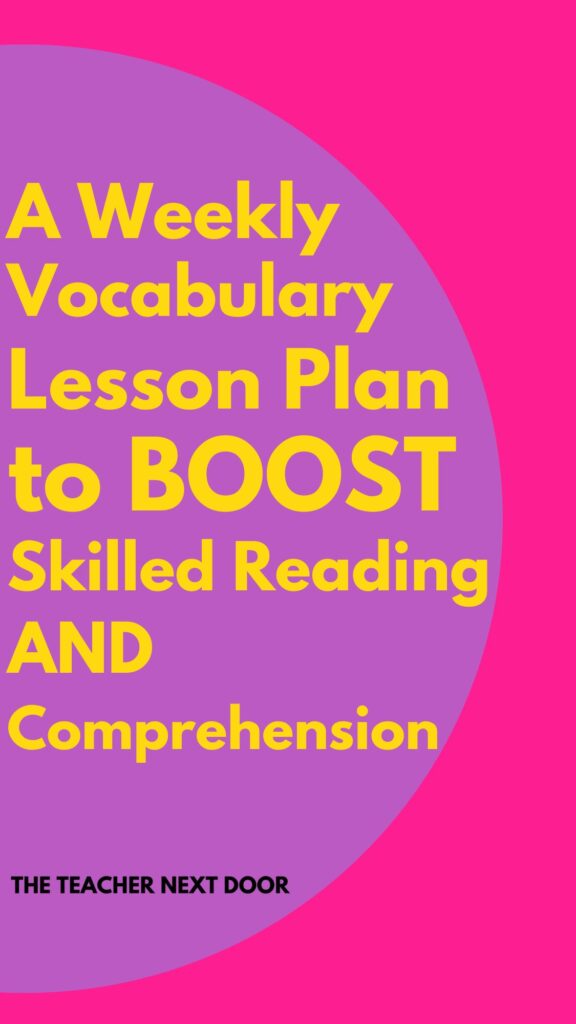
A Weekly Vocabulary Lesson Plan to BOOST Skilled Reading and Comprehension
Here’s what you can expect to learn from this article:
- The current state of vocabulary instruction at the upper elementary level
- The key vocabulary skills necessary for students to become successful readers
- A day-by-day breakdown of TTND’s strategic vocabulary instruction that you can easily implement in your own classroom
We surveyed The Teacher Next Door’s Instagram followers, and 78% (!!!) said they did not have a school-provided vocabulary program.
It’s pretty difficult for teachers to teach a vocabulary lesson when they’re not provided with resources to do so.
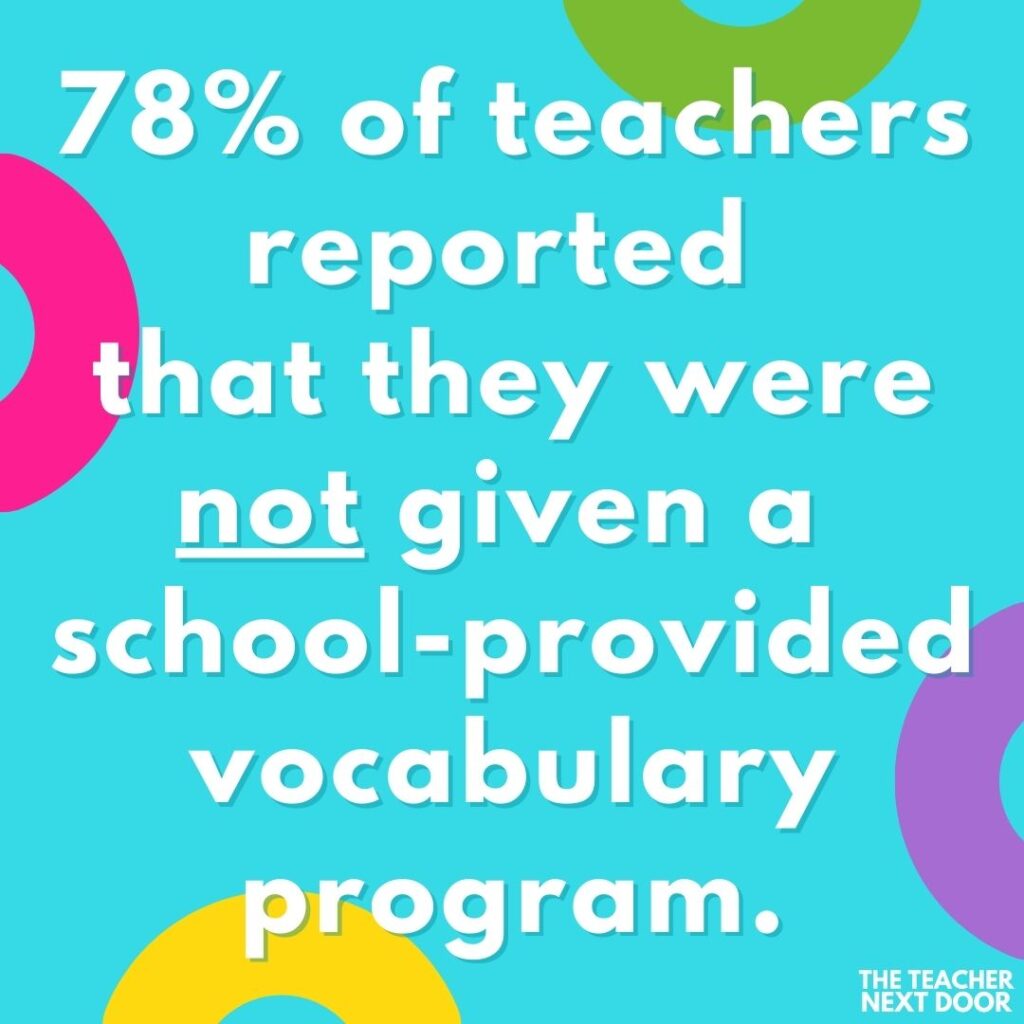
Of that 78%, 23% of teachers shared that they create their own vocabulary program from scratch.
Of the 12% of teachers provided with a school-issued vocabulary program, only 3% shared that they loved the program they were using.
The results of this survey were staggering.
It begs the question, what has happened to our elementary vocabulary instruction over the last 20 years?
Well-Developed Vocabulary is a Key Indicator of Literacy Success
Over the last century, compounding research has shown how tightly connected a student’s vocabulary is to their comprehension skills. (Baumann et al., 2003)
When it comes to vocabulary, successful upper elementary readers:
- Read multisyllabic words and use strategies to define unknown words
- Make connections between graphemes and phonemes (letter patterns and sounds) and use this knowledge to decode (read) unknown words
- Breakdown unknown words into syllable parts
- Use word analysis strategies to break unknown words down into identifiable morphemes (word parts like prefixes, suffixes, base words, roots, etc.)
(Bhattacharya et al., 2008)
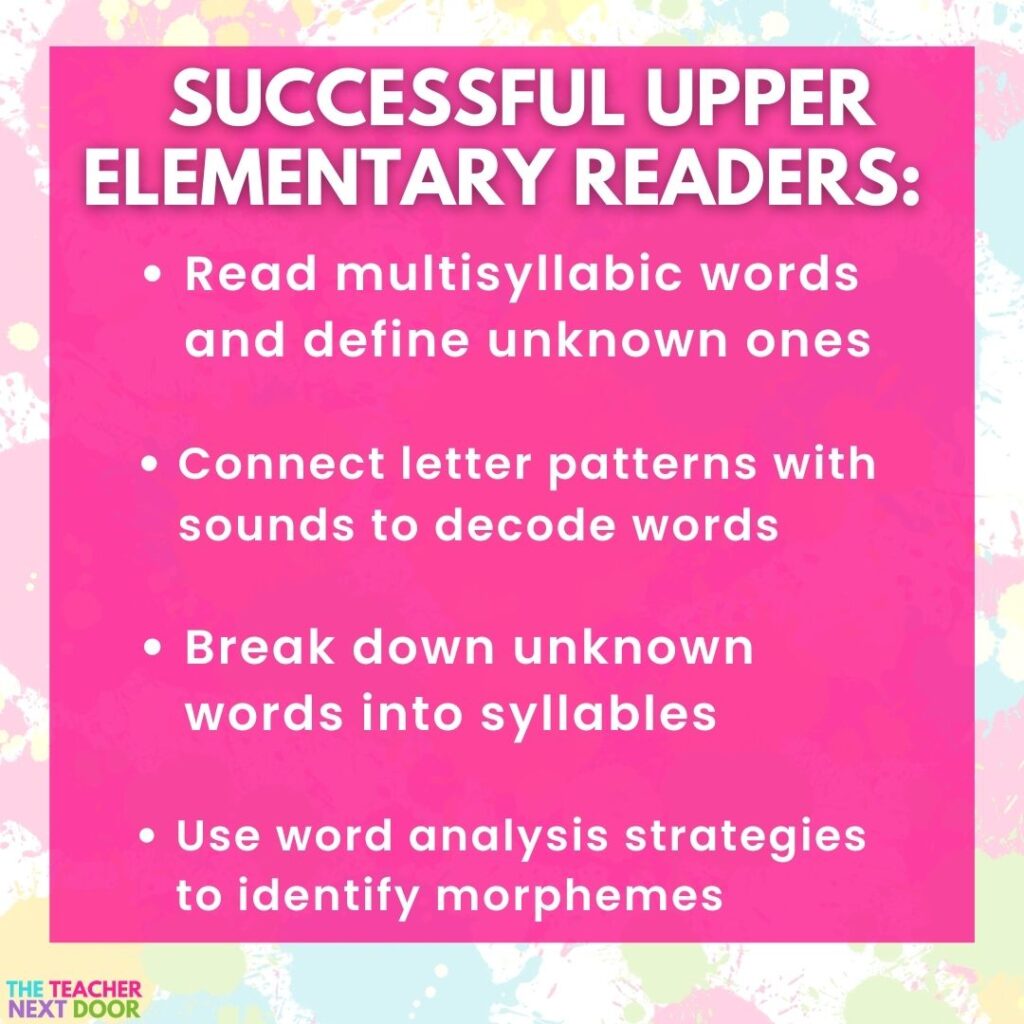
For students to become successful readers, we must provide direct and systematic instruction on morphemic analysis.
Morphemic analysis is the process of identifying (and defining) the smallest parts of a word that hold meaning.
The smallest parts of a word that hold meaning are called morphemes. Morphemes are prefixes, suffixes, and roots or bases.
At the beginning of literacy instruction, students are taught base and root words. Base words are small parts with definitive meaning that can stand independently.
As a student grows as a reader, we begin to introduce additional word parts like prefixes and suffixes that change and enhance the meaning of base and root words.
Where Current Vocabulary Instruction Falls Short
For teachers who are provided with a vocabulary program, many shared that their programs require vast amounts of memorization.
Often, big-box curriculums will move too quickly through morphology (the study of word parts and their meanings) or rely heavily on memorization.
Many students are provided with a list of words to memorize the meanings of and are tested on them at the end of the week without much direct instruction taking place.
However, as listed above, exposure and memorization aren’t enough for students to build the four skills necessary to become successful readers.
So, how do we fix our current upper elementary vocabulary instruction to ensure our students have access to the skills necessary to become successful readers?
Prefer visual and auditory learning? Check out this replay of how Erica from TTND Team breaks down the day-by-day systematic vocabulary routine below!
Adding Systematic Vocabulary Instruction Back into the Upper Elementary Reading Block
The easiest way for upper elementary teachers to implement meaningful and impactful vocabulary instruction is to add 10 minutes to the reading block daily.
However, our reading blocks are already tremendously long compared to other subjects. Something to consider here is that systematic vocabulary instruction helps yield skilled readers.
We may want to swap out a 10-minute portion of our reading skill instruction (finding the main idea, determining the text structure, determining character traits, etc.) for vocabulary instruction.
This decision will need to be made by teachers and administration.
The Daily Breakdown of Vocabulary Lessons and Morphological Instruction
Below is a step-by-step plan to include vocabulary instruction each day. This system is simple yet impactful.
Be sure to note that morphology instruction is delivered by the teacher in whole-group or small-group settings.
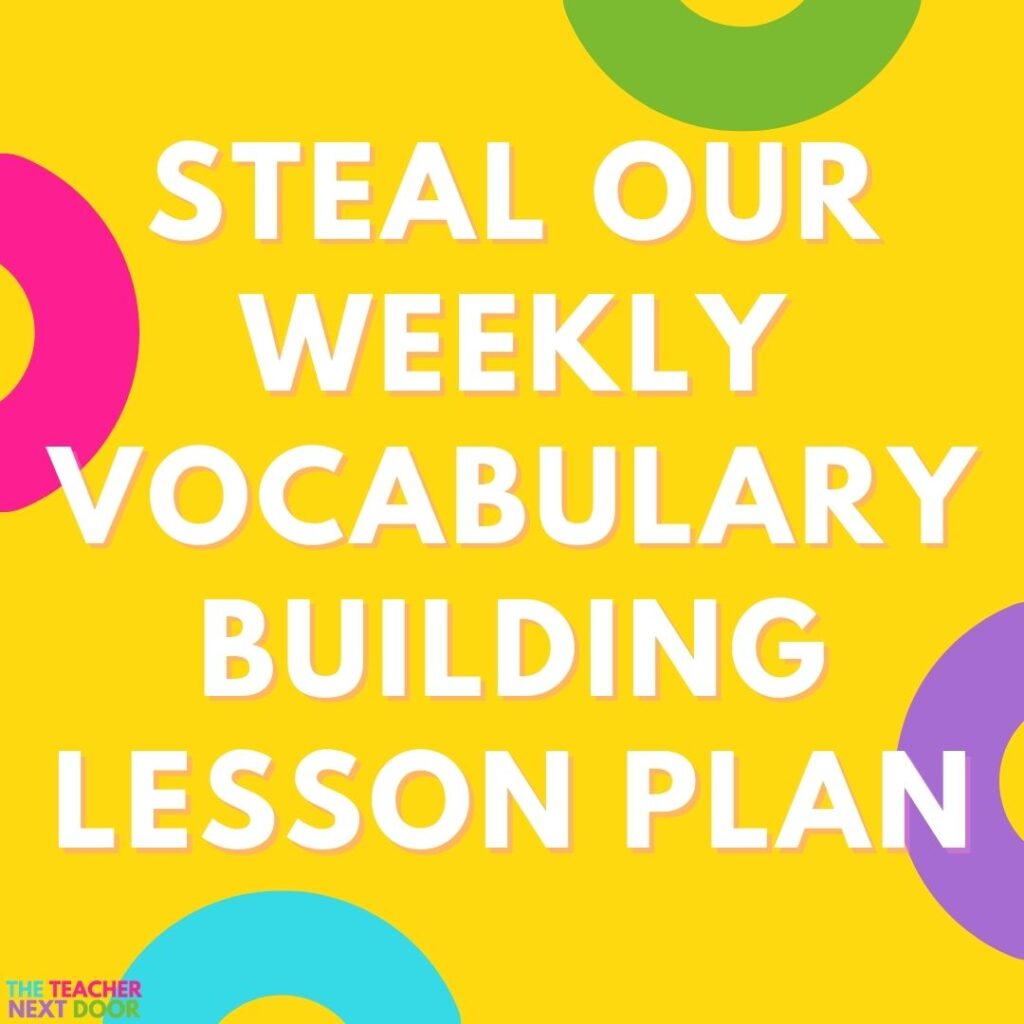
It’s important to deliver morphological instruction directly to students.
Independent practice can allow students to explore and analyze how morphological changes can impact the meaning of a word.
If you’re unfamiliar with morphological changes, we will build on this concept later in this article.
A Five-Day Vocabulary Routine That Works
Each week, you’ll be introducing one word part to students. All vocabulary words for the week will be based on that word part.
The word part introduced at the beginning of the week will be a Greek or Latin root or base word or an affix.
Helpful Morphology Tips & Examples:
An affix is a prefix that can be added to the beginning of a root or base word, or a suffices that can be added to the end of the root or base word. An affix changes the meaning of the word part.
The difference between a base and a root word is that base words can stand and hold meaning on their own. Root words must be attached to another word part (like an affix) to have meaning and cannot stand on their own.
Base Words: -graph from the word autograph
Root Words: -cept from the word expect
Now, onto the weekly routine that will help your students expand their vocabulary and word analysis skills!
Monday:
Introduce the weekly word part using an anchor chart. The chart includes the definition, three vocabulary words, and a related photo. The inclusion of a photograph is beneficial for English Language Learners.
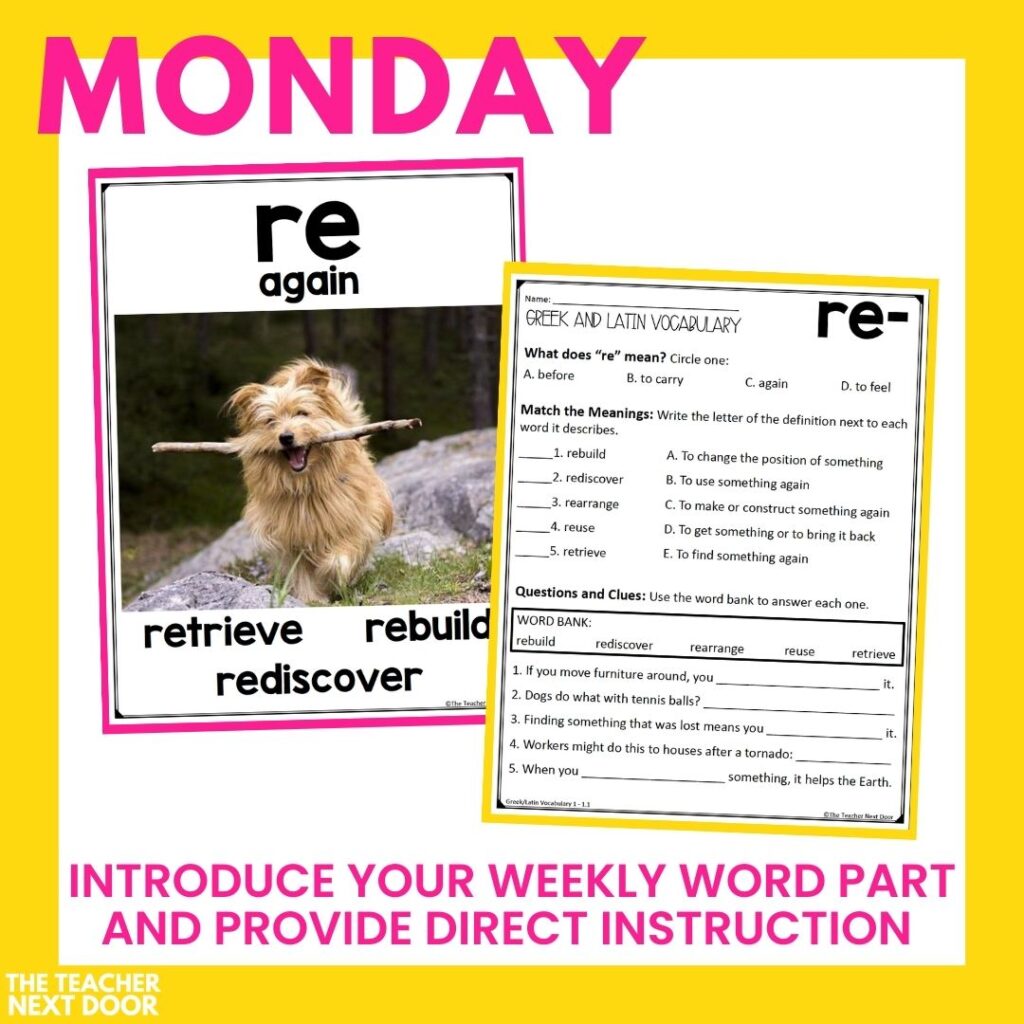
Break down the vocabulary words into word parts. Make any connections to previously learned word parts, if possible.
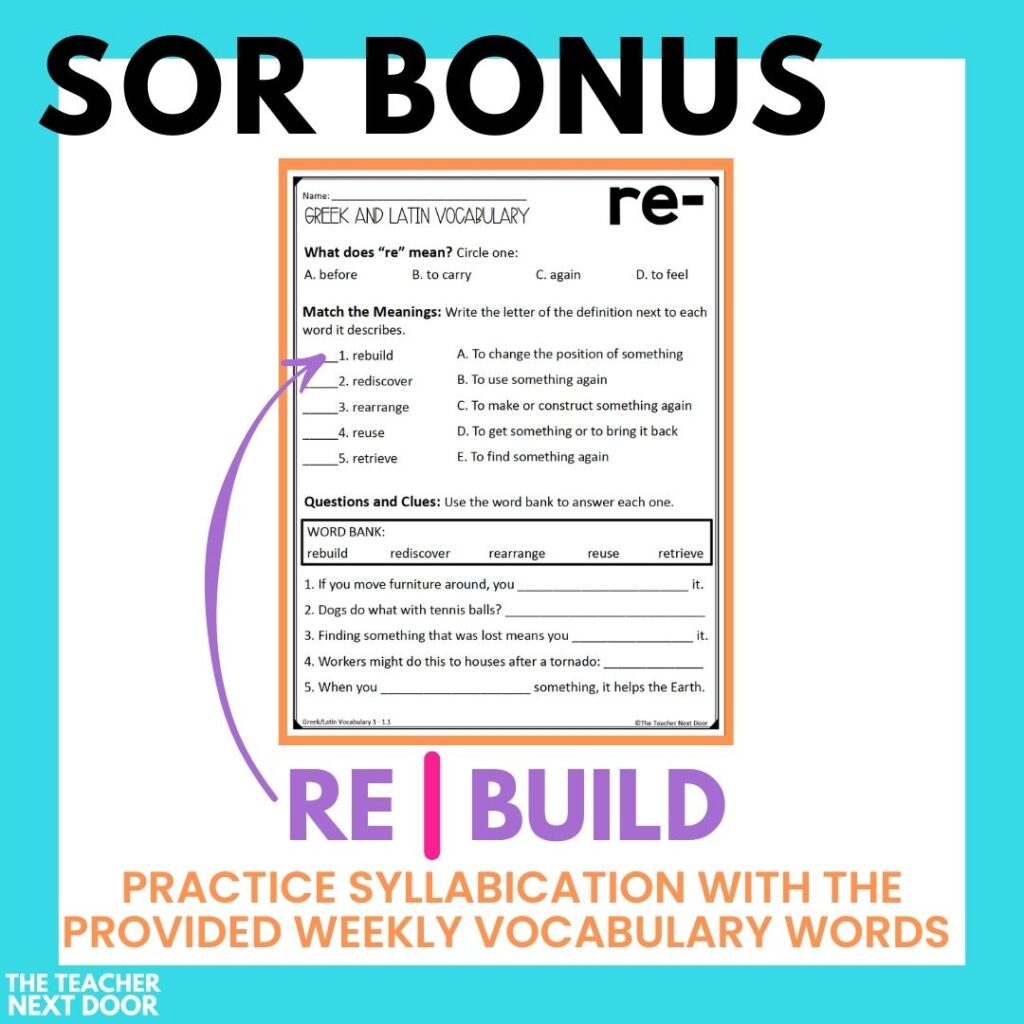
Tuesday:
Review weekly word part and vocabulary words using provided word cards. To ensure longevity, laminate the word cards and add them to your word wall or whiteboard.

You can also use these word cards for a matching activity in reading centers.
Combine two or three units’ word cards for a larger matching game to review.
Independently, have students complete the Meaning Makers activity where they will breakdown the vocabulary word into word parts, define the word, and draw a picture to represent each word.
In small groups, work to syllabicate the vocabulary words. This activity can enhance students’ decoding and spelling skills.
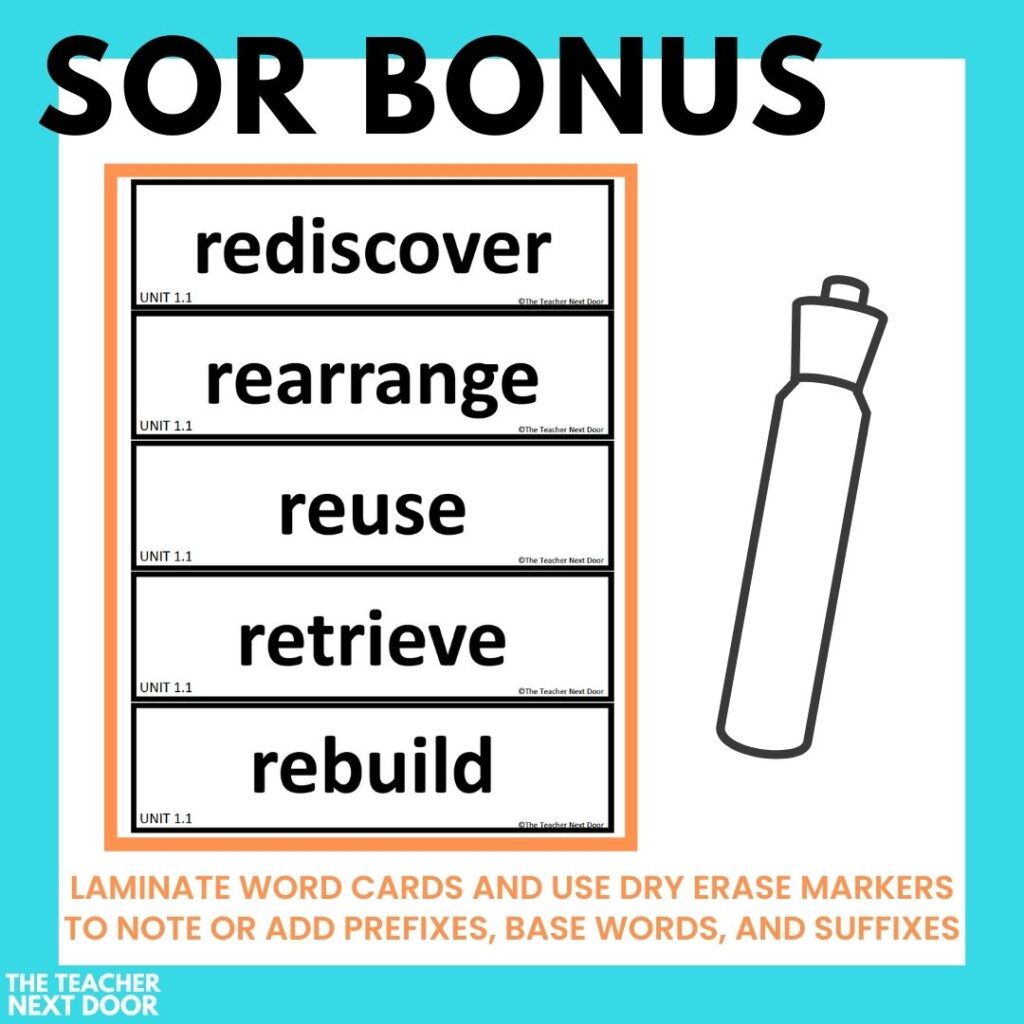
Wednesday:
Have students complete the vocabulary fluency passage or poem. Students will use colored pencils or crayons to define the vocabulary words. Students will rely on their knowledge of the weekly word part’s definition and context.
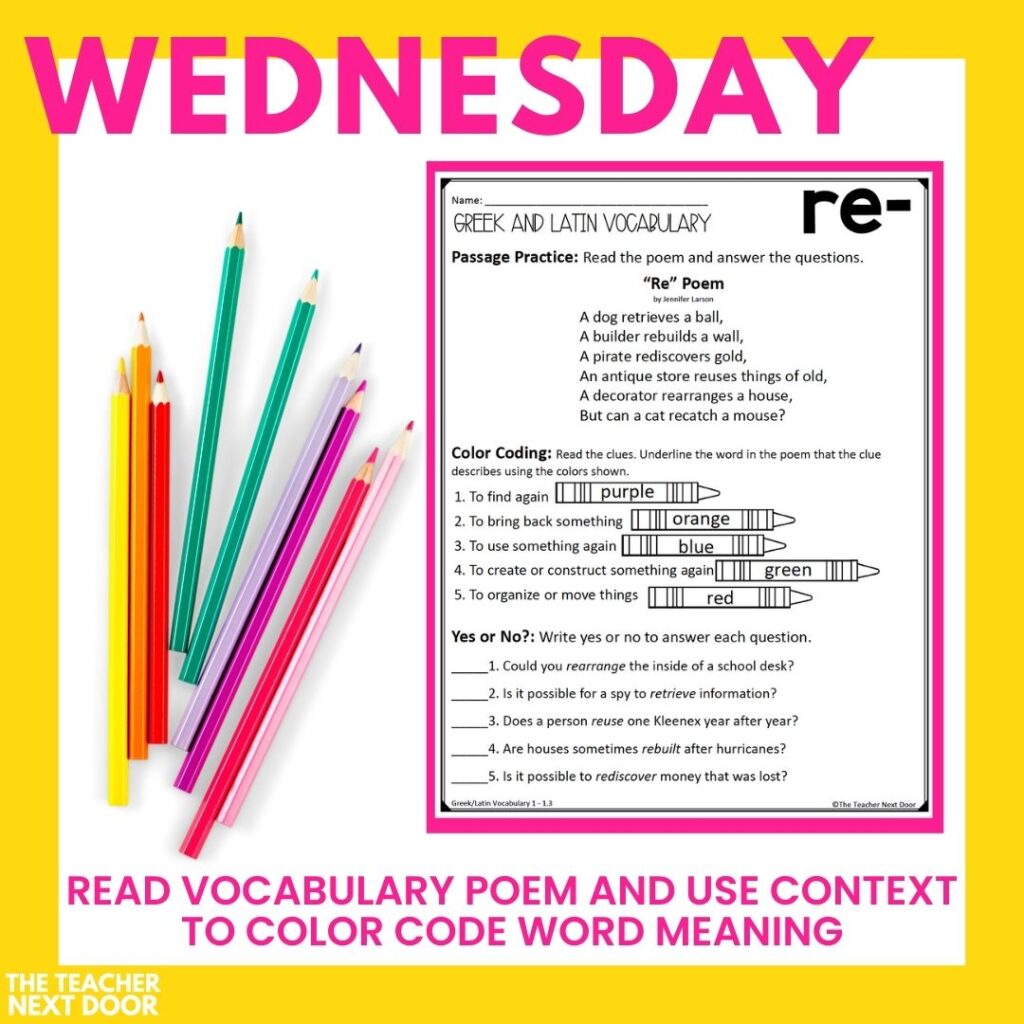
During small group instruction, use a morphology wall and have students build new words using the weekly word part and previously taught or well-known morphemes.
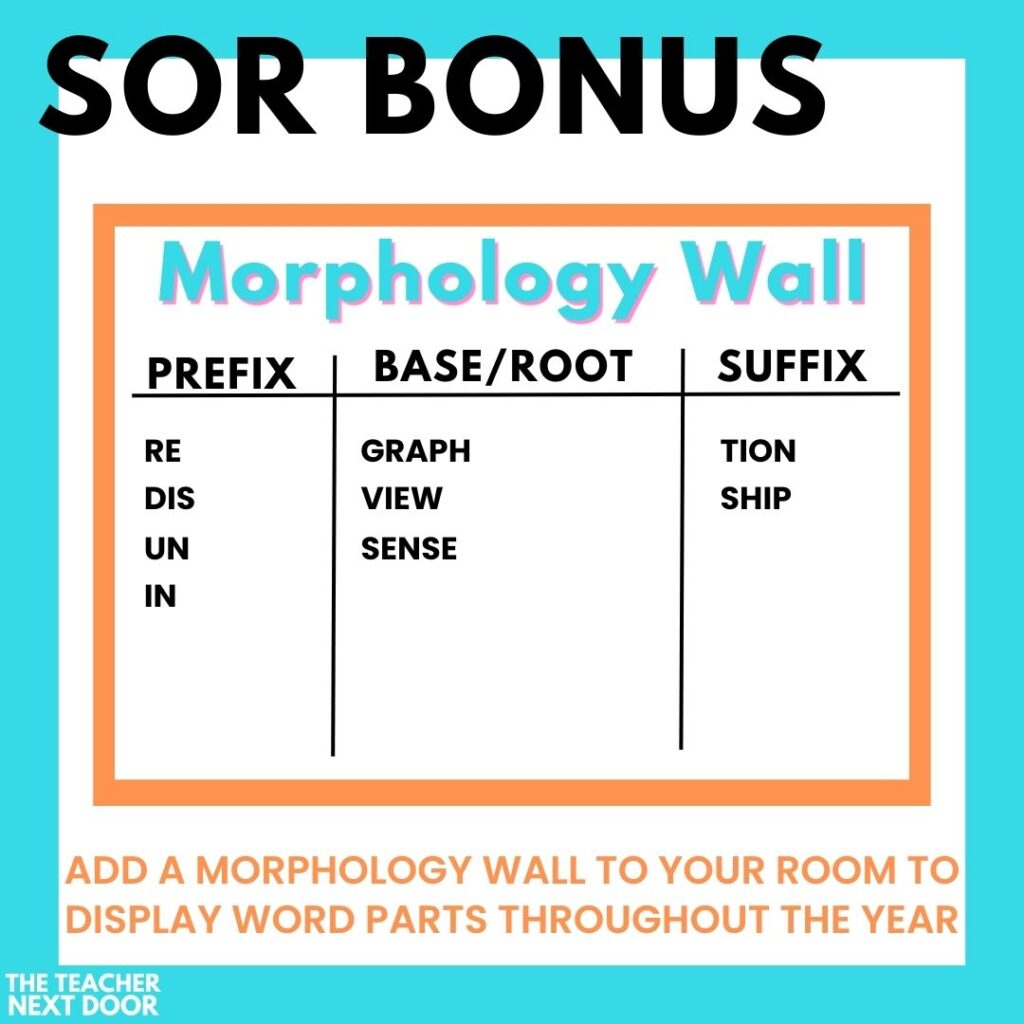
Thursday:
In partners or small groups, students will match vocabulary words and additional words that contain the weekly word part using puzzle pieces.
Have students check their work by providing them with a task recording sheet and an answer key.
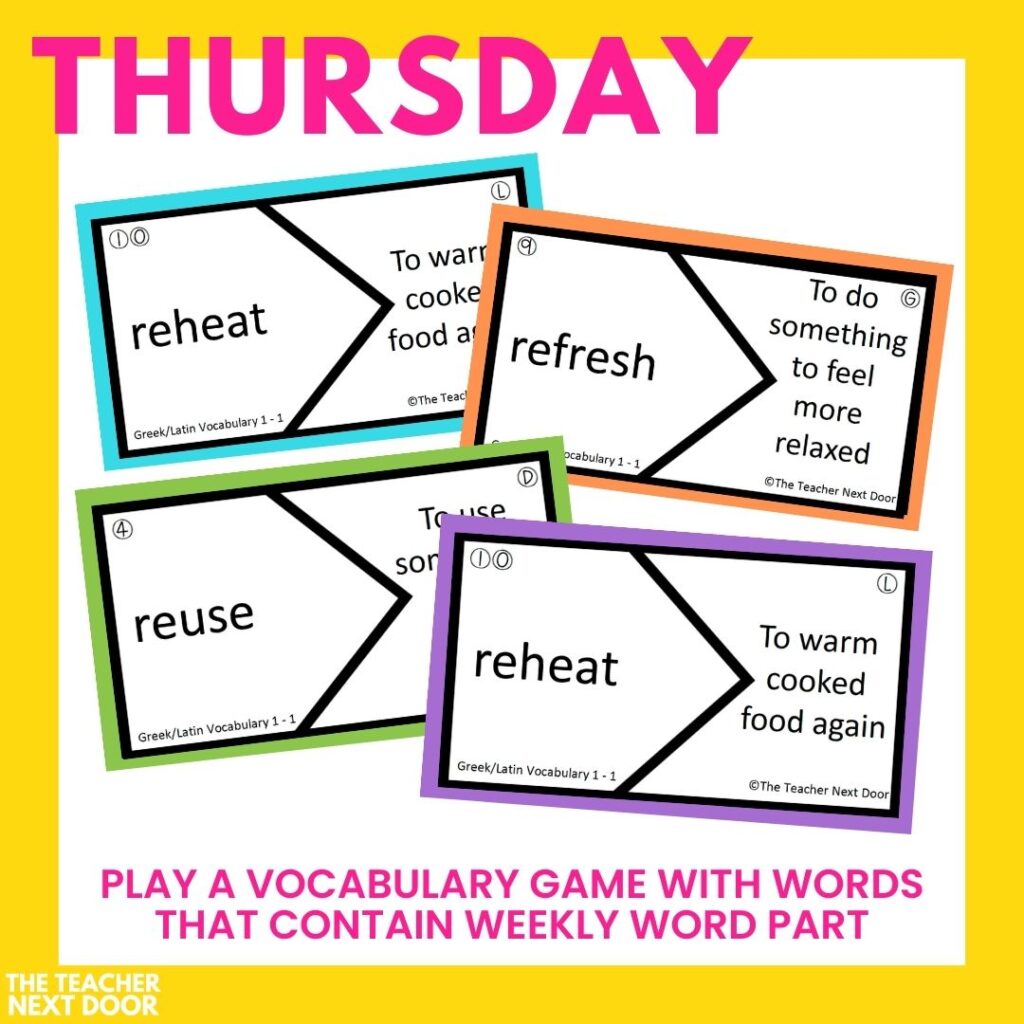
Friday:
Assess the weekly word part and vocabulary words.
Giving an assessment allows you to add a consistent weekly grade to your grade book.
For traditional report cards, these assessment grades can be averaged and reported anecdotally at the end of each grading period.
It is highly recommended that the vocabulary routine be shared with student guardians. Explain that morphology instruction will help students define unknown words throughout their schooling.
For standards-based report cards, this grade can be averaged and reported along with the standard to communicate progress for vocabulary acquisition and understanding.
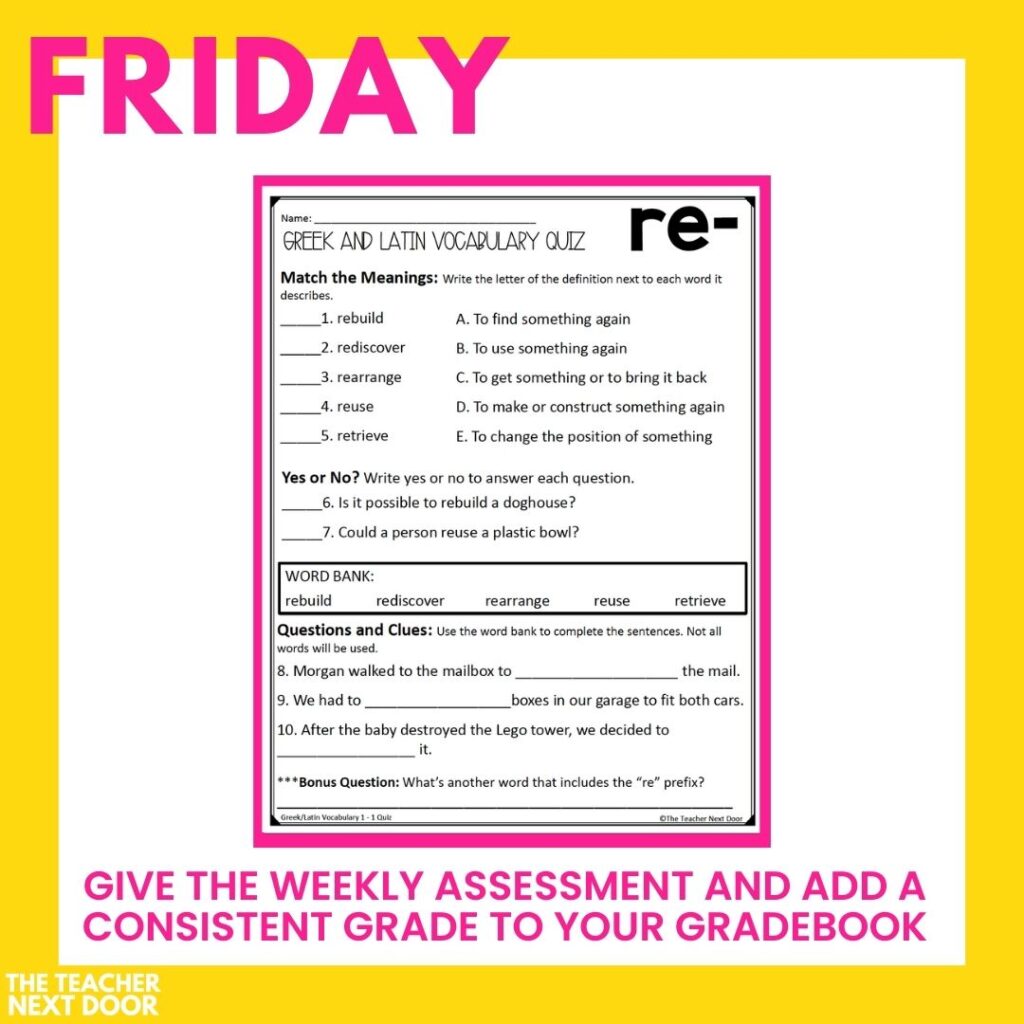
How The Teacher Next Door Can Help You Add Impactful Vocabulary Instruction to Your School Day
As shown in the above video, Erica from The Teacher Next Door Team uses a weeklong unit to teach the prefix re-. This weeklong unit is available, free of charge, to all upper elementary teachers.
Why are we offering this unit for free?
At TTND, we know that you strive to be an effective upper elementary teacher while maintaining a healthy work-life balance.
In order to do that, you need resources that are impactful, yet simple.
We were shocked to learn that so many upper elementary teachers did not have a strategic vocabulary program to rely on.
And to create one on your own would take hours upon hours of unpaid time outside of your contact hours.
We believe teachers should live their lives outside the classroom and not spend hours lesson planning and searching for resources.
We’re excited to be able to be able to give upper elementary teachers everywhere:
1) A free, printable, systematic approach to weekly vocabulary lessons
2) A free weeklong unit with every resource imaginable in print and digital format
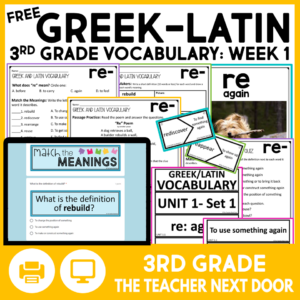
FREE 3rd Grade Greek & Latin Vocabulary Weeklong Unit
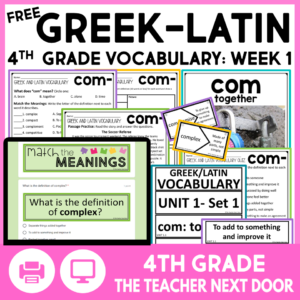
FREE 4th Grade Greek & Latin Vocabulary Weeklong Unit
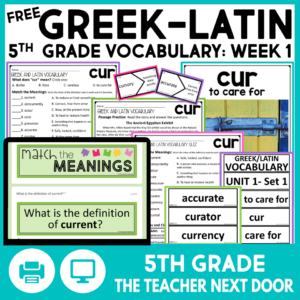
FREE 5th Grade Greek & Latin Vocabulary Weeklong Unit
Ready to take charge of vocabulary instruction in your upper elementary classroom?
The Teacher Next Door’s BRAND NEW yearlong Greek & Latin Vocabulary Units will help you include consistent, systematic vocabulary instruction throughout the entire school year.
These Yearlong Bundles include 36 word parts that will build your students’ vocabulary so that they can better access texts of all genres and content areas.
Here’s what you can find within the yearlong comprehensive bundles:
- Practice Pages for an Introduction
- 36 Anchor Charts with pictures, definitions, and word examples
- Vocabulary Cards for Word Walls, Pocket Charts, or to use as a Matching Game
- Review Pages
- Passages or Poems for each week
- Games and Activities for a fun review
- Unit Quiz/Assessment
- Answer Keys (print only – all Google Forms are self-correcting)
- Detailed Teacher Notes
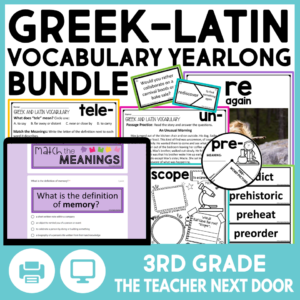
3rd Grade Greek & Latin Vocabulary Yearlong Bundle
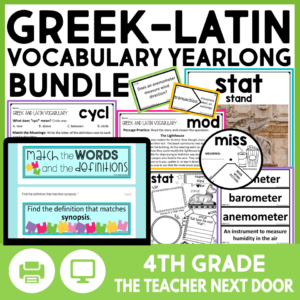
4th Grade Greek & Latin Vocabulary Yearlong Bundle

5th Grade Greek & Latin Vocabulary Yearlong Bundle
We know you’re going to love this bundle!

